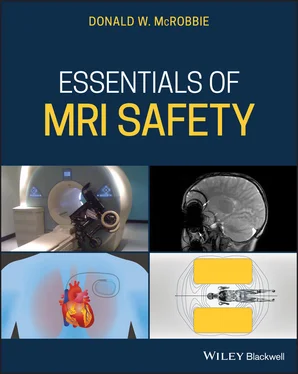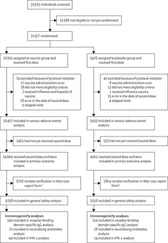1 Cover
2 Foreword: essentials
3 Acknowledgments
4 1 Systems and safety: MR hardware and fieldsINTRODUCTION OVERVIEW OF MRI OPERATION MRI HARDWARE ELECTROMAGNETIC FIELDS OTHER MEDICAL DEVICES CONCLUSIONS References Further reading and resources
5 2 Let’s get physical: fields and forcesBASIC LAWS OF MAGNETISM MAGNETIC MATERIALS FORCES AND TORQUE LORENTZ AND HYDRODYNAMIC FORCES LAWS OF INDUCTION CONCLUSIONS References Further reading and resources
6 3 Bio‐effects 1: static fieldINTRODUCTION PHYSICAL MECHANISMS CELLULAR EFFECTS ANIMAL EFFECTS EPIDEMIOLOGY HUMAN PHYSIOLOGICAL EFFECTS ACUTE SENSORY EFFECTS COGNITIVE EFFECTS STATIC FIELD EXPOSURE LIMITS CONCLUSIONS References Further reading and resources
7 4 Bio‐effects 2: time‐varying gradient fieldsINTRODUCTION PHYSICAL INTERACTION ELF TIME‐VARYING MAGNETIC FIELD EFFECTS MAGNETIC STIMULATION PERIPHERAL NERVE STIMULATION IN MRI EXPOSURE LIMITS CONCLUSIONS References Further reading and resources
8 5 Bio‐effects 3: radio‐frequency fieldsINTRODUCTION PHYSICAL INTERACTION TISSUE HEATING BIOLOGICAL EFFECTS RF EXPOSURE LIMITS CONCLUSIONS References Further reading and resources
9 6 Acoustic noiseINTRODUCTION GENERATION OF ACOUSTIC NOISE IN MRI MEASURING NOISE: dB(A), dB(C), dB(Z) ANATOMY AND PHYSIOLOGY OF HUMAN HEARING MRI NOISE EXPOSURE REDUCING ACOUSTIC NOISE IN PRACTICE HEARING PROTECTION ACOUSTIC NOISE LIMITS CONCLUSIONS References Further reading and resources
10 7 PregnancyINTRODUCTION CELLULAR EFFECTS AND ANIMAL STUDIES HUMAN STUDIES AND EPIDEMIOLOGY GADOLINIUM‐BASED CONTRAST AGENTS EXPOSURE LIMITS AND GUIDANCE CONCLUSIONS References Further reading and resources
11 8 Contrast agentsINTRODUCTION PHYSICAL AND CHEMICAL PROPERTIES CONTRAST REACTIONS AND ADVERSE EVENTS PREGNANCY AND LACTATION CONCLUSIONS References Further reading and resources National guidance documents
12 9 Passive implantsINTRODUCTION RISKS FROM PASSIVE IMPLANTS ASTM TESTING EXAMPLES OF PASSIVE IMPLANTS ARTEFACTS CONCLUSIONS References Further reading and resources
13 10 Active implantsINTRODUCTION RISKS FROM ACTIVE IMPLANTS PACEMAKERS AND ICDS NEUROSTIMULATORS COCHLEAR IMPLANTS ENDOSCOPIC CAMERAS IMPLANTABLE INFUSION PUMPS KEEPING WITHIN THE CONDITIONS CONCLUSIONS References Further reading and resources
14 11 Would you scan this? Understanding the conditionsINTRODUCTION MRI CONDITIONS UNDERSTANDING FRINGE FIELD SPATIAL GRADIENT MAPS UNDERSTANDING RF CONDITIONS GRADIENT SLEW RATE CONDITION MORE EXAMPLES OFF‐LABEL SCANNING WHAT TO DO WHEN YOU DO NOT KNOW THE CONDITIONS? CONCLUSIONS References Further reading and resources
15 12 Location, location, locationINTRODUCTION ACR ZONING SCHEME FRINGE FIELD HELIUM EXHAUST AND QUENCH PIPE SECURITY SAFETY FEATURES MRI PROJECT MANAGEMENT SPECIALIST SYSTEMS CONCLUSIONS References Further reading and resources
16 13 But what about us? Occupational exposureINTRODUCTION OCCUPATIONAL EXPOSURE LIMITS NATIONAL AND INTERNATIONAL LIMITS SURVEYS OF OCCUPATIONAL EXPOSURE LEVELS SURVEY INSTRUMENTATION INCIDENCE OF BIO‐EFFECTS AMONG MAGNET FACILITY AND MR WORKERS CONCLUSIONS References Further reading and resources
17 14 Organisation and managementINTRODUCTION ROLES IN MR SAFETY POLICY AND SAFETY DOCUMENTATION CHECKLIST AND SCREENING INCIDENTS EMERGENCIES TRAINING ACCREDITATION AND CERTIFICATION STANDARDS AND GUIDANCE EXPOSURE LIMITS CONCLUSIONS: THE LAST WORD References Further reading and resources
18 Appendix 1: One hundred equations you need to know MAXWELL’S EQUATIONS MAGNETIC FIELD INDUCTION MAGNETIC MATERIALS FORCES AND TORQUE FORCES ON MOVING CHARGES LAWS OF INDUCTION RF INDUCTION FROM THE RADIOFREQUENCY FIELD SAR AND TISSUE HEATING References
19 Appendix 2: Maths toolkitCOORDINATE SYSTEMS VECTOR ALGEBRA VECTOR CALCULUS
20 Appendix 3: Symbols and constants
21 Answers to revision questions
22 Index
23 End User License Agreement
1 Chapter 1 Table 1.1 Magnetic fields in MRI.
2 Chapter 2 Table 2.1 Magnetic susceptibility of common materials. Table 2.2 Properties of ferromagnetic metals. Table 2.3 Tissue conductivity at various frequencies. Electrical properties f...
3 Chapter 3 Table 3.1 Physical interactions and possible bio‐effects of biological materi...Table 3.2 Limits for static magnetic field exposures.
4 Chapter 4Table 4.1 Typical electric and magnetic field exposure from electrical wiring...Table 4.2 Electrical properties of excitable tissue.Table 4.3 PNS from MRI gradient coils.Table 4.4 PNS in terms of MRI gradient coil parameters.Table 4.5 Default IEC rheobase and chronaxie values [34].
5 Chapter 5Table 5.1 Attributes of RF pulses.Table 5.2 Physical properties of human tissues. Electrical properties from ht...Table 5.3 Tissue properties and heating in the absence of thermal conduction....Table 5.4 CEM43 values for tissue damage [15].Table 5.5 IEC temperature limits [30]. Higher temperature values are permitte...Table 5.6 IEC SAR limits [30]. m exposeddenotes mass of patient exposed (%), ...
6 Chapter 6Table 6.1 Octave bands used in acoustics.Table 6.2 Octave band calculation example. See http://www.hse.gov.uk/noise/ca...Table 6.3 Hearing protection class and SLC values used in Australia and New Z...Table 6.4 Times to reach occupational noise limits.
7 Chapter 7Table 7.1 Summary of human MR and epidemiological studies into EMF and pregna...Table 7.2 1st trimester MRI and pregnancy outcomes from Ray et al. [22].Table 7.3 MRI with gadolinium and pregnancy outcomes from Ray et al. [22].
8 Chapter 8Table 8.1 Gadolinium‐based contrast agents.Table 8.2 Typical relaxivities of commercial GBCAs at 1.5 and 3 T [3].Table 8.3 Physical properties of GBCAs [3].Table 8.4 Stability of CBCAs: laboratory test results [3].Table 8.5 Classification of agents by NSF risk and observed long term retenti...
9 Chapter 9Table 9.1 Categorization of interactions of passive devices with magnetic fie...Table 9.2 Summary of static magnetic field forces.Table 9.3 Magnetic and electrical properties of metals.Table 9.4 Resonant half‐wavelengths in some tissues.
10 Chapter 10Table 10.1 Categorization of interactions of active devices with magnetic fie...Table 10.2 NBG coding for pacemakers (1st three letters only).Table 10.3 MR conditional pacemakers and ICDs. Always check the most recent s...Table 10.4 Neuro‐stimulation systems. References are to recent review papers.Table 10.5 MR Conditions for various deep brain stimulation systems. Always c...Table 10.6 MR conditions for vagus nerve stimulation systems. Always check th...Table 10.7 MR conditions for spinal cord stimulators. Always check the most r...Table 10.8 MRI conditions for sacral nerve stimulators. Always check the most...Table 10.9 MR conditional cochlear implants. Always check the most recent spe...Table 10.10 Adverse events involving cochlear implants and MRI. Number of eve...Table 10.11 MR conditional implantable infusion systems. Always check the mos...Table 10.12 Field limits for the Fixed Parameter Option: basic [1, 60]
11 Chapter 11Table 11.1 Shellock ‘subconditions’. Examples are not exclusive. For each dev...Table 11.2 Tabular form of GE compatibility data for the 3 T TLC magnet.Table 11.3 Example data for General Electric 3 T TLC magnet.
12 Chapter 12Table 12.1 Typical safe operating distances for the avoidance of interference...Table 12.2 Typical distances for the avoidance of interference with B 0homoge...
13 Chapter 13Table 13.1 Static field occupational exposure limits [1,5].Table 13.2 ICNIRP Basic Restrictions for movement within the static magnetic ...Table 13.3 ICNIRP Reference Levels for movement within the static magnetic fi...Table 13.4 ICNIRP limits for time‐varying magnetic fields from 1 Hz–100 kHz [...Table 13.5 ICNIRP Basic Restrictions RF [6].Table 13.6 ICNIRP Reference Levels RF [6].Table 13.7 Action Levels from EU Directive 2013/35/EC [10].
Читать дальше












